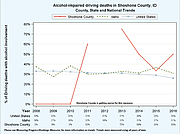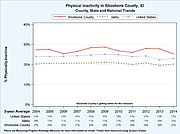Measuring up 2017: Part 2
In the Wednesday, April 4 edition, the Shoshone News-Press took a look at a recent study that ranked Shoshone County’s overall general health against the rest of the counties in the state.
The study pulled few punches and once again ranked Shoshone 41 out of 42 participating countries, only beating out our southern neighbors in Benewah County who ranked the lowest.
Conducted by the Robert Wood Johnson Foundation (RWJF) and the University of Wisconsin Population Health Institute (UWPHI), the study based its rankings off how each county fared in two main categories, including health outcomes and health factors,
With the issues facing the county’s health now presented, the SNP reached out to community officials to see what their take was.
On the law enforcement side of things, Shoshone County Sheriff Mike Gunderson and two of his deputies were happy to comment on some of the negative health factors that involve a criminal element here in our area.
The 2018 rankings report showed a rather high percentage of alcohol-impaired driving deaths (52 percent) compared to the state average (32 percent). This statistic is a 5-year average of all the driving deaths in the county which had alcohol involvement. The National Highway Traffic Safety Administration defines a fatal crash as alcohol-related or alcohol-involved if either a driver or a nonmotorist (usually a pedestrian or bicyclist) had a measurable or estimated blood alcohol concentration of 0.01 grams per deciliter or above.
The rankings also showed a high number of violent crimes (353) in Shoshone County compared to the state’s average number of 212. Defined by the rankings as “offenses that involve face-to-face confrontation between a victim and a perpetrator, including homicide, rape, robbery, and aggravated assault,” the violent crime statistic is found by combining the last three years of available data provided by the FBI’s Uniform Crime Reporting (UCR) Program.
Sheriff Gunderson was not surprised with either of these statistics, due mostly to several unique factors that influence Shoshone County.
“Thats what we’ve been seeing too,” he said. “We have a lot of violent crimes, unfortunately. We deal with a lot of domestics and simple assaults.”
Idaho State Police’s (ISP) yearly crime report on the county backs up Gunderson’s statement, showing that “simple assault” and “battery” consistently rank in the top five of most reported offenses.
The causes for this high violent crime rate are arguably numerous, but a stagnating local economy certainly does not help.
“Some of our highest paid jobs are impacted right now and these numbers are going to go up and down as a rule,” Gunderson added.
A lull in the economy also brings with it a higher number of residents using illegal substances- another factor that SCSO Capt. Jeremy Groves says may contribute to violent crime.
“There’s cases and times where that is fueling it (violent crime) because they have no other option really,” he explained. “They have to feed the addiction, so if you don’t have money or items to trade or buy the product, you have no other choice.”
“Drug related” incidents also hold a place in the top five most reported offenses on ISP’s yearly report for our area.
When it comes to the high percentage of alcohol-impaired driving deaths, Gunderson, Groves and SCSO Undersheriff Holly Lindsey agree that much of those are side-effects of an increased population during the summer months when Shoshone Count becomes a outdoor recreation destination.
“A lot of our (alcohol involved) fatalities are from recreational use,” Gunderson explained. “We have a high recreational use area.“
To back this up, Gunderson cited several UTV/ATV related deaths in just the past few years that occurred primarily in the North Fork Coeur d’Alene River area. When individuals come to recreate in that area, the use of alcohol usually come with them.
Lindsey explained that, “this is an area in the summertime where our population sprouts … A lot of these violent crimes that they speak of probably happen up the Coeur d’Alene River North Fork, and they probably occur because of alcohol being involved, and they probably involve people not from our county.”
Known by many in the Silver Valley, the presence of Interstate 90 right through the center of our area makes it easy for non-residents to come into town. Groves explains that the ease of access to Shoshone County makes it hard not to invite trouble from other places.
“Look at some of our vehicle pursuits or things like that in the last year, they aren’t residents,” he said. “They are people coming through or problems coming from different states or other counties that wind up here, then we wind up dealing with them or assisting.”
To limit drunk driving, Gunderson stresses that his office tries to at attack the issue on two fronts — on the road and in the classroom.
“What we try to do is try to be out there and enforce,” he said. “We do a lot of educational classes with the schools to try and talk about alcohol related behavior.”
Activities in these classes include having students wear “beer goggles,” to simulate how vision is impaired when intoxicated, and staging a mock DUI crash to stress the serious of the topic.
Another area that Shoshone County came up short in was Health Behaviors. Though many areas improved compared to the previous year, the county’s adult obesity rate (30 percent) and percentage of physically inactive adults (25 percent) still remains high. Ironically, one of the few strengths the county had once again was a high percentage of the population that have access to exercise opportunities.
The obesity statistic is based on responses to the Behavioral Risk Factor Surveillance Survey (BRFSS) and is the percentage of the adult population (age 20 and older) that reports a body mass index (BMI) greater than or equal to 30 kg/m2. Data is provided by the CDC Interactive Diabetes Atlas, which combines three years of survey data to provide county-level estimates.
Physical inactivity is also determined based on responses to the Behavioral Risk Factor Surveillance Survey and three years of county-level survey data from the CDC Interactive Diabetes Atlas. The measure is the percentage of adults ages 20 and over reporting no leisure-time physical activity in the past month.
SMC Fitness Center Manager Jonnie Nelson says that even though she is pleased the numbers have improved since last year, there is still a lot more residents can do to continue improving their overall health.
“Getting some fresh air and being active can not only lower your stress levels,” she explained. “But it will also add up to healthy life-changing progresses.”
Stressing the County’s high “access to physical activity” statistic, Nelson adds that our area provides a wealth of physical activity options, making it likely that theres something out there for everyone.
“Between the hiking, swimming, bike trails, fitness classes, and gyms available here in the Silver Valley, there has to be some kind of physical activity to look forward to doing again and again.”
Shoshone Medical Center in Kellogg (the area’s only medical resource in most cases) also offers several options to promote healthy lifestyles such as tobacco cessation classes and physical therapy/ rehabilitation programs.
With 16 percent of adults in the County identifying as smokers and almost as many being inactive, these services could be helpful to many.
To see Part 1 of this article, visit www.shoshonenewspress.com/local_news/20180406/measuring_up_2017_part_1.
To see the full rankings report, visit www.countyhealthrankings.org and search for Shoshone County.





